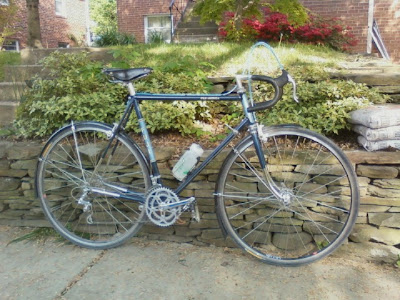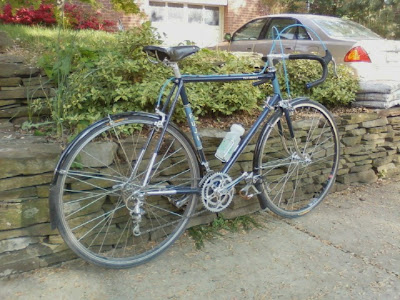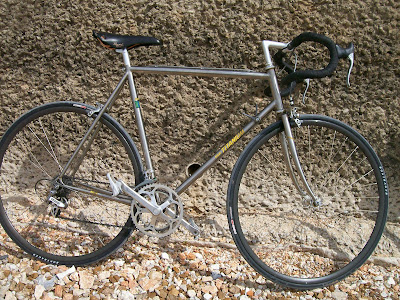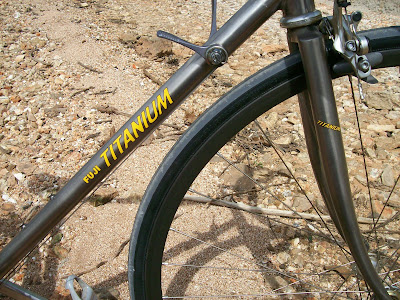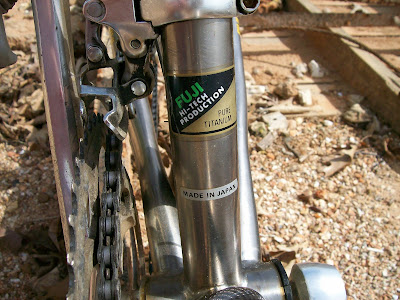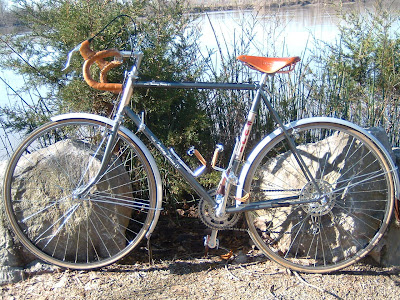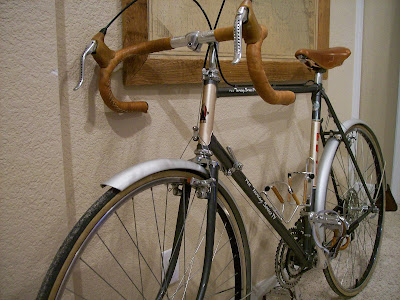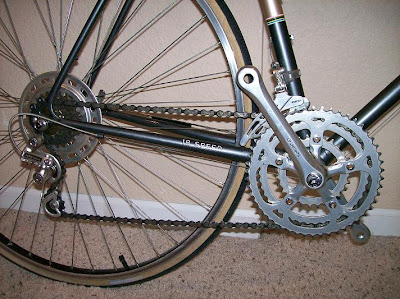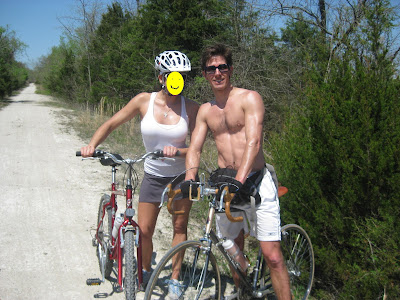In the last installment of the
Ticino hubset saga, we were just going gaga ogling these fine new production hubs from
Electra Bicycle Company:
However, as much as I liked just having these gleaming on my desktop, it was really time to get these into some wheels. But before going into that, I want to discuss the hubs in a little more detail.
In addition to their great looks, the Ticino hubs are obviously a high quality item. The machining is very precise. The hubs are anodized, but with such care to polishing the substrate that they are some of the shiniest anodized alloy parts I've ever seen.
The styling is obviously a tribute to the C-Record sheriff's star hubs, but with some more modern lines. To be specific, there is no relief line between the spoke ring and the star "arms". Interestingly, there is such a relief line on the inner side of the flanges on the front, so it was obviously a stylistic choice rather than a cost-cutting measure.
And Electra is taking no chances about whether or not it is an urban myth that C-Record high flange hubs were prone to failure. The spoke rings and star arms are all pretty beefy and the corners of the cutouts have a fairly large radius that will avoid stress concentration.
The stainless steel fitments and axle are similarly polished and seem nearly surgical grade.
Here is a closeup of the non-drive side of the rear hub:
I got curious about what was beneath that pretty housing, so I got out the 15mm and 17mm cone wrenches and went exploring:
Nothing to see here folks except the ceramic cartridge bearings that make these hubs silky smooth. As a note, an Electra rep informed me that the grease ports on the axle housings are functional in that there is no inner seal and one could actually grease the cartridges this way. I found that oddly soothing, knowing that this grease port and clip weren't just completely non-functional costume jewelry.
However, these grease ports will probably be used about as often as they were on old Campagnolo hubs, which is to say nearly never.
Overall, these things are a simply stunning combination of form and function. But I would run the risk of being a total Electra fanboy/shill if I didn't point out some issues.
Despite looking over these in some depth, I really couldn't find much to kvetch about on the hubs themselves. The front hubs don't have the glitzy alloy bearing cover as does the non-drive side rear - the spacer nut bumps up against the bearing. That is pretty small potatoes, to say the least, and is just a matter of taste.
The quick release skewers, while being every bit as precious as the hubs, had two small nits that are petty and picayune on my part. The first was the method of attachment of the quick release lever:
As you can see, it goes all the way through the cam housing and is secured by a circlip. During a major overhaul, I like to disassemble, clean, and lubricate QR mechanisms and circlips are a big PITA.
Beyond that, it is a bit of an agricultural-looking touch on what are otherwise beautifully detailed hubs. On C-Record and Suntour Superbe Pro quick releases, the lever end is blind. Here is a Superbe Pro (I have a C-Record downstairs, it looks largely the same..):
The second nit is the turn clip on the quick release adjustment nut. It is loose in its holes. Traditionally, these clips are a bit of an interference fit so that they don't move with gravity. In addition to lending a bit of cheapo-ness to the quick release, the clip can actually jangle around a bit. When I'm riding, any little tink or rattle gets my attention and makes me start worrying about what the heck is going on.
In this photo, we can see that the Ticino quick release nut turning clip can't stand up to the competition:
From left to right, we have Campagnolo Croce d'Aune, Maillard/Spidel 700, Suntour Superbe Pro, and finally, Electra Ticino wilting a bit.
Me, I'm certain that when Electra reads this, they will be positively mortified and rectify this dreadful situation immediately...
But seriously, these are uber-fine hubs that I couldn't wait to get on the road and all this QR stuff is extreme bike part geek pickiness that matters not a whit to anyone. So I assembled all the materials:
The rims are Velocity Synergy, 32 hole (like the hubs, obviously). The spokes are DT stainless, butted. For durability, I go with brass nipples and for traditionalism, Velox rim tape. The hubs need no introduction nor does the box in which they have been residing.
Then, after the pasta but before the wine,
a miracle happened and voila!:
This was my first experience with Velocity Synergy rims and it was a very good one. They built up very much in round with even tension between the spokes. Also, the wheelbuilding dimensions Electra sent me for these hubs were quite accurate. I didn't double check them and just plugged the numbers into Spokecalc - the resulting spoke lengths worked perfectly.
I also have to put in a plug for my truing stand:
Wheelbuilding is an exercise in nitpickiness. One of the nits is how to line up the label - traditionally, this is done so that the label is viewable via the valve hole. However, the Ticino brand is engraved around the circumference of the axle housing, so what is an obsessive compulsive wheelbuilder to do?
By the way, I do mean engraved rather than the cheaper laser etching so common these days. Maybe it was done with a laser, but the power must have been turned up pretty darn high, as the engravings are pretty deep and are definitely not going to come off with a little simichrome.
But back to the point - the obvious answer for the hub/rim alignment issue in the Ticino case is to line up the oil port with the valve hole, as one can barely see in this shot:
The next day, it was time to saddle up and take these out. But first I had to run up to the LBS and pick up a cassette. I ended up with a pretty decent Shimano 11-30 8 speed. With that option, I decided it was high time to swap the existing 52/36 chainrings for 48/34 ones.
Beyond that, I snagged the leather wrapped bars from my Fuji Gran Tourer. I've been considering leather wrap as the final handlebar treatment on this bike, so this would give me an actual look.
With that work accomplished, I headed out for the secret Fuji Otaku test track, which runs about 25 miles through Rock Creek Park and then up the Capital Crescent Trail.
Of course, I stopped for pictures:
I was a little concerned about going with black rims, but I am delighted with the results. This is definitely in line with the hot rod Lincoln idea I've got going on with this bike. The black leather Fujitoshi stitch-on handlebar wrap is tearing it up as well.
The hubs received a little end user love and tenderness in the form of blue paint in the cutouts. Note the aforementioned relief line on the inside of the front hub flange:
This matches up with a lot of blue detailing showing up elsewhere on the bike. By happy coincidence, the label on the cassette is blue:
The Fuji America is also sporting some Suntour Superbe pedals now in addition to previously installed Superbe bottom bracket, brake calipers, and downtube shifters. When I finalize this bike, it will also have Superbe brake levers:
Here is another shot of this bike, which is really shaping up with a lot of help from the Ticino/Synergy wheelset:
In my humble opinion, the Ticino hubs and black Synergy rims suit this bike to a tee.
As for the test ride, the hubs were quite smooth and uncomplaining. The freehub has an audible tick but is rather quieter than period freewheels. For me, this is definitely a good thing - a freehub or freewheel that makes a little noise can alert pedestrians to a cyclist's approach.
In summation, I'm delighted with my new wheels and the Ticino hubs. A little bit of attention to detail on the QR skewers and we won't have anything to complain about at all, which would be quite a novelty.
